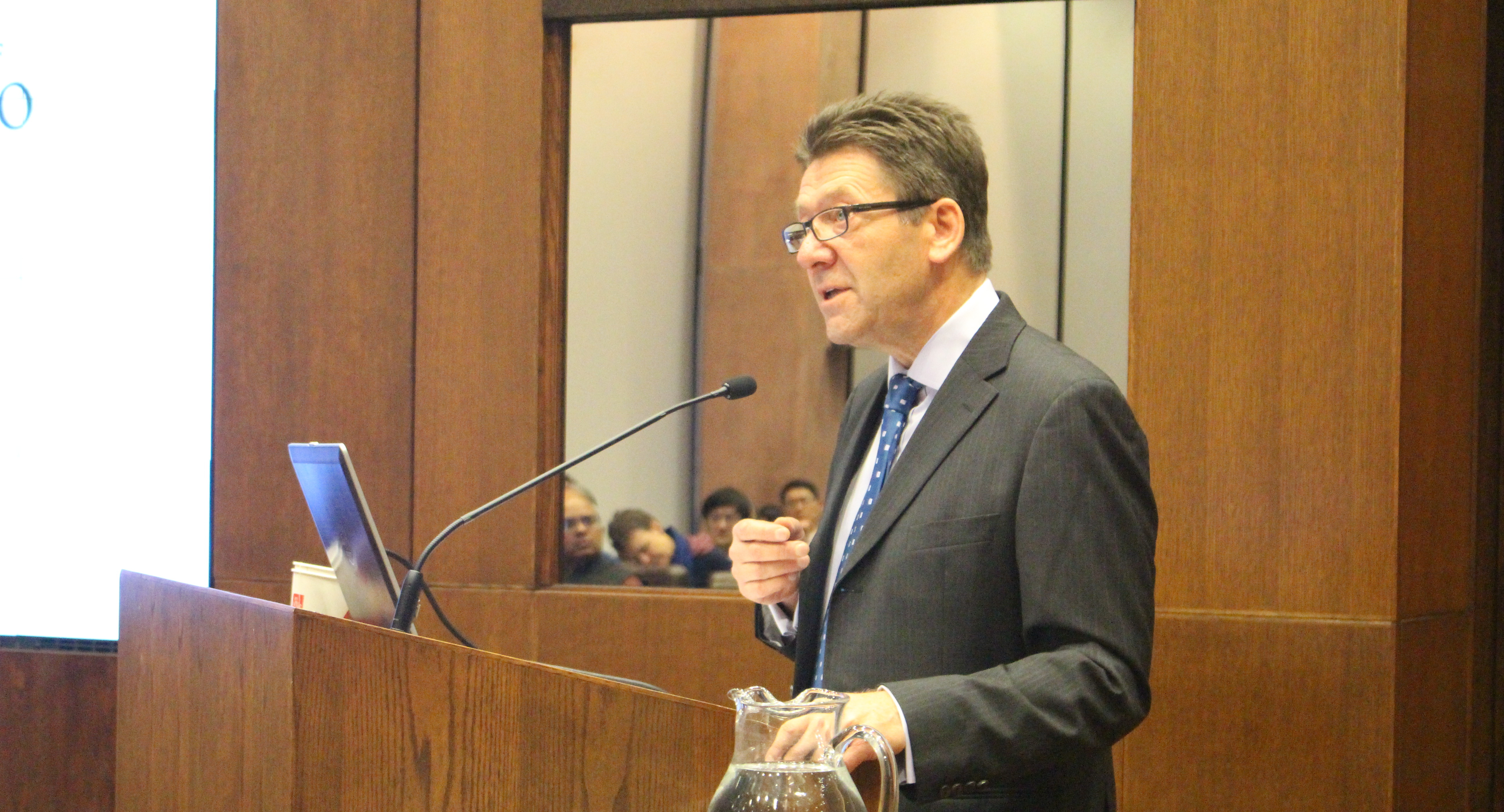Thomas Blom Hansen, Professor of Anthropology at Stanford University, delivered the 2015 India-Canada Association Lecture titled, “Urban Theory Goes South: On the Historicity of Space and Urban Imagination in South Asia” at the Munk School of Global Affairs on November 26, 2015. At the event sponsored by the Centre for South Asian Studies and the Asian Institute at the University of Toronto, the Centre’s Director Professor Ritu Birla and Consul General of India, Mr. Akhilesh Mishra introduced Hansen’s body of work and its scope.
The number of megacities, many of them with the oldest and biggest slums, is increasing in South Asia. Hansen argues that urban theory needs to develop new models based on non-European and non-American cities and observe the cities as such instead of studying them with the Marxist or modernist utopian visions of what they should look like. Hansen proposes three assumptions underlying his theory: First, cities commodify land; second, social relations and identities in cities are remade as communities give way to individualism and egalitarian relations; and the lastly, cities are secular spaces.
Evaluating Michel de Certeau’s notion that a modern individual as a pedestrian can carve out his or her own space in the cities, Hansen contends that the notion works better in a monolingual, navigable and intelligible city space. The colonial and postcolonial cities are different because they have little or no free movement; race and residential segregation define them; and caste and religion control them. Parks, beaches and other public spaces common in European cities are largely absent in the colonies. Instead, social, religious relations and rituals are the ethno-racial markers of the communities and neighbourhoods in the colonial cities. For example, the Ganapati Utsav festival and the riots in Bombay in the last decade of the nineteenth century created the urban, nationalist, Hindu sovereignty that identified Muslims as enemies. As the communities spread, each one produced a separate statue of Ganapati to be taken to the sea. In this case, social spaces are redefined through: the creation of neighbouring communities, the consolidation of the Maharashtrian Marathi speakers’ identity, the intensification of class and caste divisions, and the strengthened rural links of the people. With the rise of Shiv Sena in the 1960s, the utopian version of the right to the city remodelled Bombay as a more domesticated and welcoming city to Marathi speakers.
At the same time, urban space is a self-making environment. From a close proximity emerges an elementary form of tolerance. For this very reason, secularism in cities has existed in practice for a long time. One can refer to the practice as a civilized coexistence of the ‘one’ and the ‘other’, that is, of the ‘self’ and the ‘stranger’. The doubling of an individual takes place in cities because race, gender or other categories of identities make the self appear like the other simultaneously.
Hansen then turns to the assumption that cities are secular spaces. Small temples, painted stones, trees worshipped as spirits, shrines of saints, mosques, madrasas, Salvation Army churches, or catholic churches are around every corner in cities like Bombay. The districts with such signs are now sharply marked. Bombay’s municipal corporation tried to pull down the unauthorized shrines in 2003. The effort to remove these mundane forms of the sacred, although not easy to conceptualize, ended up in long term social and court battles fought by social workers or aspiring politicians. Even the new high-rises in the cities cater to the already comfortable groups. Hindus and Muslims are buying apartments near temples or mosques in India as they are doing similar things in Durban, South Africa. In the city of Aurangabad, once founded by an Ethiopian slave Malik Amber and then renamed after a Mughal king, more Hindu nationalists entered and settled in 1980s, and they wanted call it Shivaji city. The name of the city remained unchanged after a counterproposal to rename it after its Ethiopian founder. The playing field has changed as the Hindu nationalists came to power, and the city has implemented new rules targeting Muslims. The city’s Islamic architecture has suffered from neglect ever since. The case shows that networks of communities and neighbourhoods focus on the optimal outcome for their communities rather than for the city as a whole.
Hansen concludes that modernity in India has been articulated through these multiple forms of stymied urban space. Class, caste, religion, the public styles of the Muslim and the Hindu modernities, and modern consumer societies have always marked the self. Ethnic markers in the cities have evolved but not dissolved.
Pushpa Raj Acharya is a PhD student in Comparative Literature and South Asian Studies at the University of Toronto.








